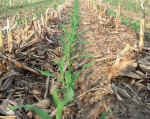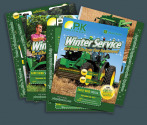Farm Equipment
Future-Planned Facilities
Over the years, we've covered a wide variety of topics impacting equipment dealers. Here's a summary of some of the special coverage we've focused on.
In 2016, our panel of judges once again had an impressive pool of candidates to choose from for this year's Dealership of the Year honorees.
After comparing all of the nominees, the judges made their choice and Farm Equipment’s 2016 Dealership of the Year is Van Wall Equipment, a John Deere dealership based in Perry, Iowa, with 16 ag locations. In addition to its ag equipment stores, Van Wall also boasts 2 power sports stores, 2 material handling, 3 Golf & Turf and 2 CCE stores.
READ ABOUT THE WINNERS | WATCH THE 2016 VIDEO SERIES | PAST WINNERS
Nominate a dealer for the 2017 Dealership of the Year program
 After the Ink Dries:
After the Ink Dries:Dealers and consultants share their lessons learned on best practices for integrating your company culture into a newly acquired store.
 Supplier Prospectus
Supplier ProspectusThe Farm Equipment Supplier Prospectus is a special digital media compilation that you can turn to time and again as you evaluate your many choices in our vibrant agricultural equipment industry. The prospectus includes digital features, from videos and photo galleries to catalog and brochure downloads. This unique compilation is intended to help you better "get to know" more than 60 of our industry's key suppliers who continue to help our industry advance.
 Success in Shortline Machinery
Success in Shortline MachinerySuccess in Shortline Machinery is a regular feature for E-Watch, our bi-weekly e-newsletter. It is brought to you by Art's Way Mfg.
 Two Perspectives on
Two Perspectives onWe examine the profitability and potential in strip-till, sharing insight from dealers that are successfully selling and supporting the system, as well as farmers about what they want and expect from local retailers.
 Precision Farming Dealer Summit
Precision Farming Dealer SummitThe first-ever Precision Farming Dealer Summit attracted a sold out crowd of diverse dealers to share, learn and network. The event, held at the Marriott Downtown Hotel in Indianapolis, Ind., on Jan. 5-6, 2016, drew a crowd of 197 precision farming professionals from more than 50 different dealerships throughout North America.

This unprecedented, "Dealership Minds: Profile of a Successful Dealership" from Farm Equipment takes you face-to-face with the key players inside a dealership.
Learn first-hand about their challenges and successes on the road to being an industry leader.
2016: Kern Machinery SPECIAL REPORT VIDEO SERIES
2014: Champlain Valley Equipment SPECIAL REPORT VIDEO SERIES
2012: Precision Equipment SPECIAL REPORT VIDEO SERIES
2011: Birkey's Farm Stores SPECIAL REPORT VIDEO SERIES
 Used Equipment
Used EquipmentNorth American farm equipment dealers are victims of their own success. Record sales of high horsepower tractors and combines during the last decade resulted in a huge backlog of used equipment — much of it low hour, high dollar machines — that was traded in to help fund the purchase of newer units. We interviewed small-store leaders within our Dealership of the Year Alumni Group to learn about the actions they're relying on to guide them through the choppy waters of reducing equipment backlogs.
 The Best of Dealer Winter Service Promotions
The Best of Dealer Winter Service PromotionsStaying steadily busy during the off-season with billable work is a universal challenge for dealers. One way to manage it is through winter service programs, in which customers are encouraged to bring in their farm equipment for off-season maintenance and inspections. This gives dealers work through the winter and helps customers get ready for spring.

Farmers need partners who understand their business, and can leverage expertise and experience to help them accomplish the goals of their entire farming enterprise. They’re demanding it today, and will demand more of it in the future.
This special reprot, presented in a format similar to that of a Harvard Business Review case study, examines scenarios of 5 different high-income farmers along with recommendations and perspectives from leading ag consultants. In addition, you’ll see a series of “homework questions” for each case study. We’d encourage you to take a few minutes to ponder these thought-provoking questions with your team. And when finished, check the “Expert’s Comments."
Click on the report you'd like to read below:
The Farm Equipment Supplier Prospectus is a special digital media compilation that you can turn to time and again as you evaluate your many choices in our vibrant agricultural equipment industry. The prospectus includes digital features, from videos and photo galleries to catalog and brochure downloads. This unique compilation is intended to help you better "get to know" more than 60 of our industry's key suppliers who continue to help our industry advance.

With the support of WEDA, this special report discusses the data available for dealers and how to use it to benchmark your operations against the rest of the industry. It also provides a historical perspective to illustrate how dealers have progressed in improving their financial and operational metrics.
How to Use CODB Numbers to Up Your Dealership's Performance |
What the Numbers Can Tell Us | How Far Have We Really Come?

Dealers who have updated and modernized their facilities — from the showroom to the wash bay and everywhere in between — have found new efficiencies throughout the company.
2015: Read Report | Extras
2013: Read Report

A look at customer intelligence & CRM use in leading industries like auto retailing illustrates the opportunities ahead for progressive ag equipment dealers.
We sent dealer vetern Mike Wiles, with 10 years of experience as a store manager at S&H Farm Supply, to attend the 2014 Digital Dealer Conference, the leading conference for digital strategy marketing for auto dealers.
For only the second time in 10 years more dealers anticipate lower sales in the year ahead than expect an increase. Half of the slightly more than 300 North American farm equipment dealers responding to Farm Equipment’s “2015 Dealer Business Outlook & Trends” survey expect sales revenues to decline in the year ahead compared with the year passed. The last time a larger percentage of dealers expected sales to fall than to rise was in 2010 following the economic crisis brought on by the collapse of the U.S. housing market, which took most of the economy down with it.
In this report, we take a closer look at the numbers.

Is bigger still better? What's ahead for upping farm productivity?
While ‘speed’ has taken center stage in ag’s push for increased productivity, industry experts say it will take more than going faster through the farm field to meet the growing demand for agricultural commodities.

In the summer of 2014, Farm Equipment examined the subject of succession planning from the rarely-covered vantage point of the successor generation.
In this report, you’ll hear from 8 next-generation leaders (all under the age of 42) telling their own stories — and in their own words — of what’s happening at their place.

Consultants and manufacturers weigh in on 7 options that are bandied about, and whether equipment dealers could see new or evolving models popping up around them.
Interviewed for this report were George Russell, Currie Management Consultants; Charles Glass, Glass Management Group; Tony Bakker, Monosem; Jim Boak, Salford Group; Tom Evans, Great Plains Mfg., Rusty Fowler, Krone North America; and Ward McConnell, Art’s Way Mfg.

With such dramatically differing views of the practice of vertical tillage out there, we invited tillage tool manufacturers to offer their definitions of vertical tillage and what it's supposed to accomplish.
We also asked for their views on why so many discrepancies exist about vertical tillage in the market today.

It may seem that brand loyalty is disappearing, but farmers say they’re as loyal to their ag equipment dealers and brands as ever.
READ 2014 REPORT | READ 2011 REPORT

As the cost of machinery continues to escalate and farmers grow their operations, operators are becoming more demanding. While relationships and pricing remain key ingredients of the sales process, farmers want more from their sales contacts; they want experts who can provide a breakdown of costs of owning and operating a piece of farm machinery. They want an account executive who understands the impact of depreciation rules and applies them to their greatest advantage.
With a several year run of strong farm equipment sales, dealers are seizing the opportunity to upgrade their facilities, many in a ‘big’ way. Most new stores are taking on more of a ‘retail feel’ with customer comforts and amenities in mind. But beyond being far more accomodating than traditional dealer facilities of the past, several of the new dealerships are also being designed and built for practicality, efficiency and productivity, first.
While adapting many of the features suggested by their major suppliers, most are also adding their own distinctive touches to set themselves apart.
In their own words, four retired ag equipment executives describe how and why the industry has dramatically changed the way dealers do business.
For this project, we interviewed, Charlie Gause, retired John Deere vice president of marketing, Jim Irwin, retired Case IH vice president of North American business, Robert Radcliffe, retired chairman, CEO and founder of AGCO Corp., and David L. Kahler, retired executive director/CEO of the Ohio-Michigan Equipment Dealers Assn.

In this special report, Farm Equipment examines how weather patterns will change the equipment farmers utilize and dealers sell.
From interviews with weather experts, we found an overwhelming consensus that “the weather is simply going to be more volatile.”
Farm equipment dealers are putting as much or more emphasis on the used segment of their business as they do new equipment.

Five specialty equipment executives sat down with Farm Equipment editors and talked about how they're responding to their dealers' changing needs and what they see coming down the road that will impact how dealers do business.
Machinery rolls teamed with multi-unit discounts are a boon to farmers and manufacturers, but what’s in it for dealers?
 The series, sponsored by Great Plains Manufacturing of Salina, Kan., chronicles Frank Lessiter’s journey on a Mississippi River grain barge carrying $5.4 million in cargo. Lessiter’s first-hand experience on the barge (an opportunity seldom afforded to the media), coupled with 40-plus years of agricultural reporting, raised numerous questions regarding the goal of 300-bushel corn and the ability of the U.S. to transport that grain with an aging river infrastructure.
The series, sponsored by Great Plains Manufacturing of Salina, Kan., chronicles Frank Lessiter’s journey on a Mississippi River grain barge carrying $5.4 million in cargo. Lessiter’s first-hand experience on the barge (an opportunity seldom afforded to the media), coupled with 40-plus years of agricultural reporting, raised numerous questions regarding the goal of 300-bushel corn and the ability of the U.S. to transport that grain with an aging river infrastructure.